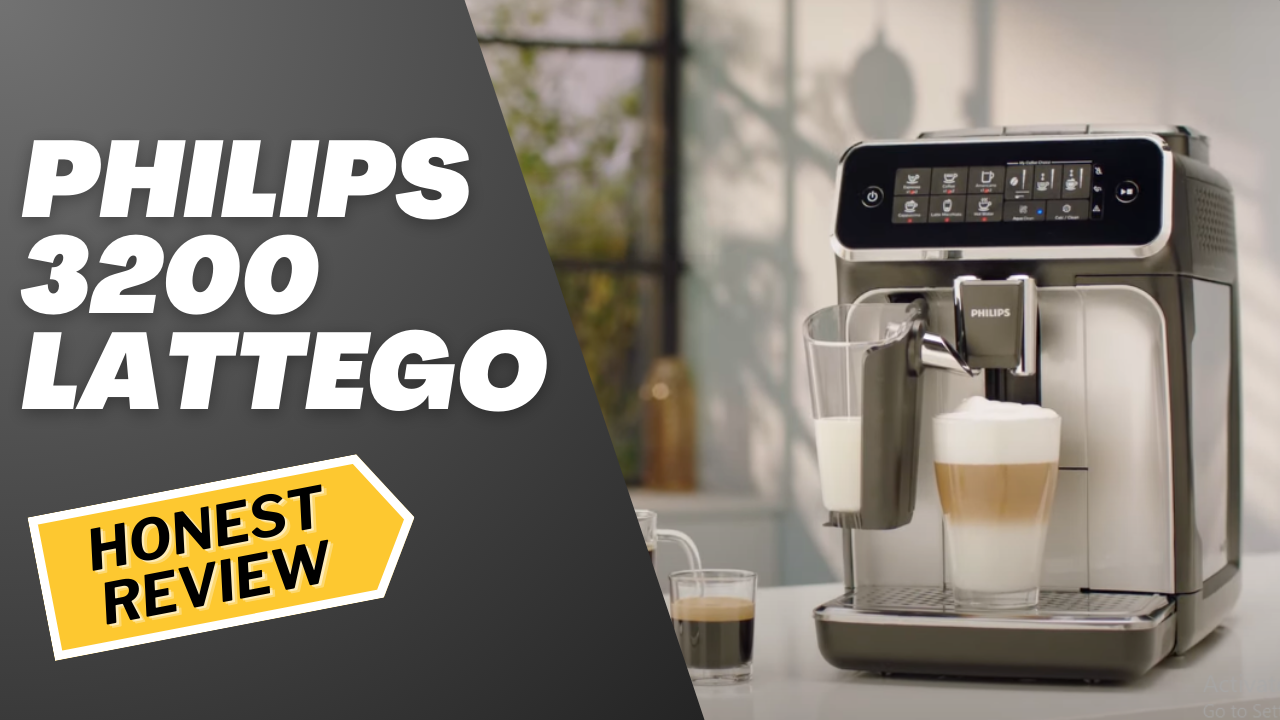Quick Answer: I’d only recommend getting the Philips 3200 LatteGo if you’ll primarily use the machine to make milk drinks. If you mainly drink plain espresso then I’d instead recommend the Delonghi Magnifica Evo.
The Philips 3200 LatteGo is one of the most popular affordable super-automatic espresso machines.
In this Philips 3200 LatteGo review, I’ll explain why I think it’s one of the most user-friendly super automatics out there and why I recommend it to people who drink a lot of milk drinks.
I’ll also look at some of the machines’ weaknesses, mainly its watery espresso and its grinder’s tendency to block up, and I’ll give some workarounds to minimize these shortcomings.
Let’s get started.
Should I Buy the Philips 3200 LatteGo?
I’d only recommend the Philips 3200 LatteGo if all of the following apply to you:
You primarily drink milk-based beverages (cappuccinos, lattes, etc.).
You want a super-automatic espresso machine with a milk frother instead of a steam wand.
Your budget is capped at $800.
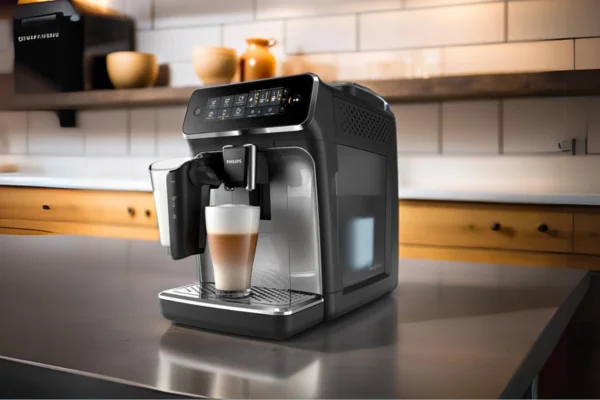
Philips 3200 LatteGo
The Philips 3200 LatteGo’s one-touch drink customizations and lack of milk tubing make it easier to use and keep clean than all other super-automatic espresso machines.
Philips 3200 LatteGo: Performance Ratings
| Category | Rating | Comments |
|---|---|---|
| Espresso Quality | ★★★☆☆ (5/10) | Decent, but lacks body compared to Delonghi models. |
| Milk Frothing Performance | ★★★★☆ (7/10) | Thick, consistent froth, but lacks variety in texture. |
| Ease of Use | ★★★★★ (9/10) | User-friendly, intuitive controls with a TFT display. |
| Ease of Cleaning | ★★★★★ (10/10) | Dishwasher-safe parts and no messy milk tubes. |
| Design & Durability | ★★★☆☆ (6/10) | Plasticky build, concerns about long-term durability. |
| Value for Money | ★★★★☆ (8/10) | Great features at an affordable price. |
If you will primarily drink plain espresso, then I’d recommend the Delonghi Magnifica Evo instead of the Philips 3200 LatteGo.
Delonghi super-automatics make better-tasting espresso than Philips machines due to their use of higher-quality brew baskets in their brewing mechanism.
The Delonghi Magnifica Evo’s milk system is more difficult to keep clean than the Philips 3200’s, so I’d recommend the Philips over the Delonghi to cappuccino and latte drinkers.
REASONS TO BUY
- It’s one of the easiest super automatic espresso machines to keep clean.
- It’s easier to customize your drinks with than most similarly priced espresso machines.
- It needs less descaling than most espresso machines.
REASONS TO AVOID
- It produces inferior espresso to a Delonghi or Jura super automatic espresso machine.
- Its grinder and bypass chute are prone to clogging because steam rises up into it.
- Its drip tray has sharp edges that you can easily cut your hand on.
Philips 3200 LatteGo: Key Features
| Specification | Philips 3200 LatteGo |
|---|---|
| Description | Super automatic espresso machine with milk frother |
| Milk system | Detachable milk carafe |
| User interface | Button only |
| Number of available black drinks | 3 |
| Number of available milk drinks | 2 |
| Strength settings (per drink) | 3 |
| Size settings (per drink) | 3 |
| Milk size settings (per drink) | 3 |
| Available milk textures | 1 |
| Double shot feature | Yes |
| User profiles | No |
| Grinder type | Ceramic flat burr grinder |
| Number of grind settings | 12 |
| Cup clearance | 3.3” – 7” (spout moves up and down) |
| Dimensions (width x depth x height) | 9.7″ W x 17.0″ D x 14.6″ H |
Initial Start-Up
The Philips 3200 LatteGo runs a long rinse cycle and then requires you to run a water hardness test before you can use it.
This water hardness test tells the machine how many brews it needs to complete before it requires descaling. The machine comes with a water hardness test strip.
You can see how this works in the video below (watch from 0:25 – 2:33):
It’s not immediately obvious how to “tell” the Philips 3200 how hard your water is. It’s always confusing when one button has several functions. I think someone would struggle to do this test without this instructional video.
The Philips 4300 LatteGo, which has a TFT display screen, walks you through this water hardness test step by step. The Philips 3200 LatteGo would be much easier to start up if it did the same.
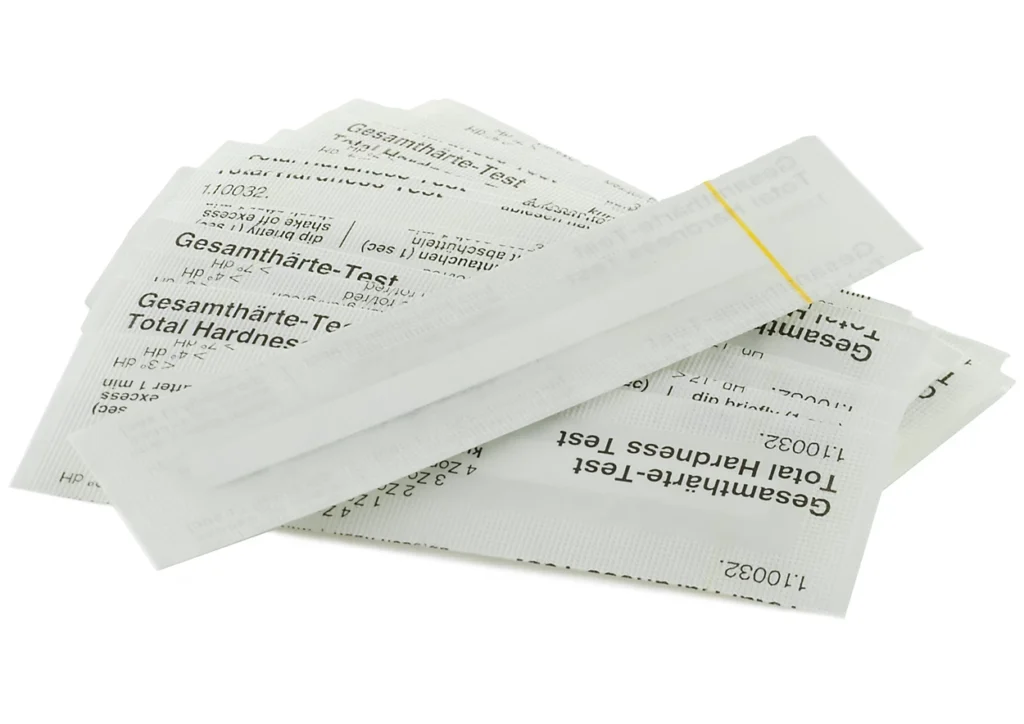
User Interface
The Philips 3200 LatteGo’s user interface is cilips 3200 LatteGo’s contrlearly laid out. I like how there are dedicated lights to tell you when the machine is out of water or when its drip tray needs emptying.

My only criticism of the machine’s control panel is that it has a generic warning light.
According to the machine’s manual, this can mean that either the machine’s brew group is out of position, or blocked or that there is air in the machine.
It would be nice if the machine could tell you exactly what the problem is and how to fix it rather than just giving you a flashing warning light. I’d dread whenever this light went off as I knew I’d have to test lots of different issues to troubleshoot the machine.
Drink Options
The Philips 3200 can make five coffee drinks. Three black coffee drinks and two milk-based drinks.
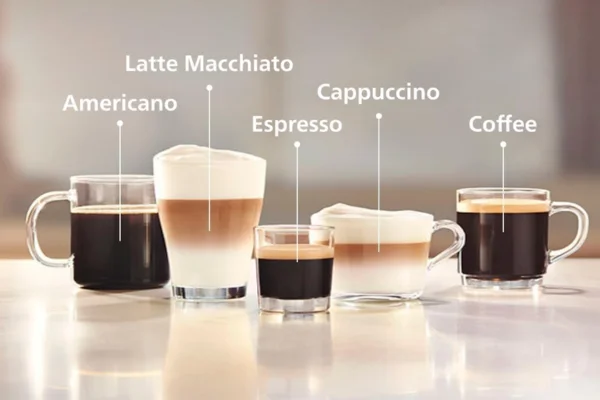
I will give my thoughts on them now – please note that my thoughts are based on my Philips 4300 LatteGo which uses the exact same coffee brewing and milk steaming system as the 3200 LatteGo.
1. Espresso
Rating: ⭐⭐⭐ 5/10
Not the best. The flavor is okay but it’s lacking in the syrupy body that defines the drink. You get the best results if you max out its strength and brewing temperature. Even then it’s inferior to what you’d get from a Delonghi fully automatic espresso machine. Better than Nespresso though.
2. Coffee
Rating: ⭐⭐⭐⭐ 8/10
I like this. It’s not far off the drip coffee I get from my SCAA-certified drip brewer. It’s FAR better than Keurig coffee. The machine grinds your coffee beans and brews your coffee in three stages so the drink is not weak or watery.
3. Americano
Rating: ⭐⭐ 4/10
Terrible. It’s a true Americano in that it’s an espresso followed by a squirt of water. This just makes an already watery espresso even more watery. Avoid.
4. Cappuccino
Rating: ⭐⭐⭐ 7/1
This was nice once you gave it a light stir. Since the machine produces a thick milk foam it will just sit on top of your coffee rather than mixing in with it. A light stir will integrate some of the milk with your coffee while still leaving some milk on top. Stirring too hard will cause the milk foam to lose a lot of its texture though.
5. Latte Macchiato
Rating: ⭐⭐⭐⭐ 8/10
This is better than the cappuccino. The machine dispenses the milk first, then pauses to let it settle a bit before it adds the espresso. This leads to better integration of the coffee and the milk, creating a nicely layered drink (see photo below). No need to stir before drinking.
In short, I’d regularly drink the Philips 3200 LatteGo’s coffee and latte macchiato.
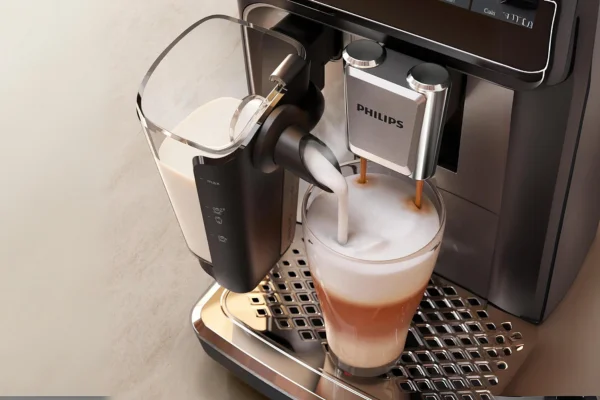
Its cappuccino is pretty good and its espresso is ok by super-automatic espresso machine standards.
Its espresso is quite a way off what you can get with a traditional semi-automatic espresso machine with a steam wand. It’s also noticeably worse than what you’d get from a Delonghi or Jura super-automatic espresso machine.
Its Americano is terrible. You really need a semi-automatic espresso machine to make a good Americano (all super automatics do it badly, not just the Philips 3200).
Drink Customizations
The Philips 3200 LatteGo gives you three strength and size options for each drink, as well as three sizes for the amount of milk you have in your milk drink. I like how you can make these changes with one button press.
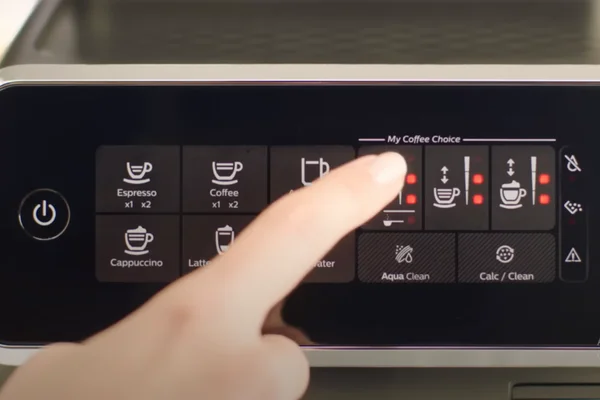
The differences between each size depend on the drink you’re making. For example, the differences in each size for a coffee will be larger than for an espresso since coffee is a longer drink than an espresso.
You make these adjustments by pressing a button.
I much prefer this to machines that have “customize modes” which require you to start and stop brewing when you hit your desired amount (most Delonghi super-automatic espresso machines use this system).
Although “customize modes” give you maximum precision, I’d rather just have the convenience of bumping up my coffee’s size and strength with a button press.
You can also adjust the Philips 3200 LatteGo’s brewing temperature by doing the following:
- Turn the machine off.
- Hold down the coffee size icon until that button illuminates.
- The three coffee-size options now correspond to three brewing temperatures. The larger the size the higher the temperature.
- Press the start/stop button to confirm your selection.
- Turn the machine back on.
I’d always recommend brewing on the machine’s highest setting.
LatteGo Milk System
The Philips 3200 LatteGo milk system is a carafe that attaches to the machine. It’s much easier to keep clean than any other fully automatic espresso machine’s milk system.
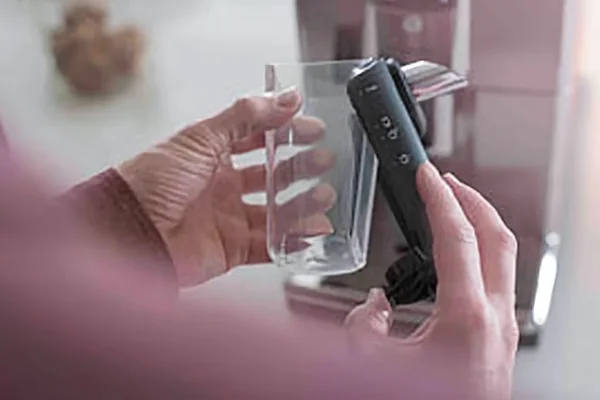
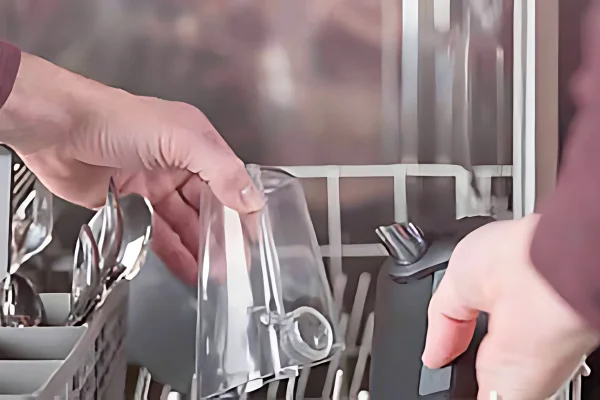
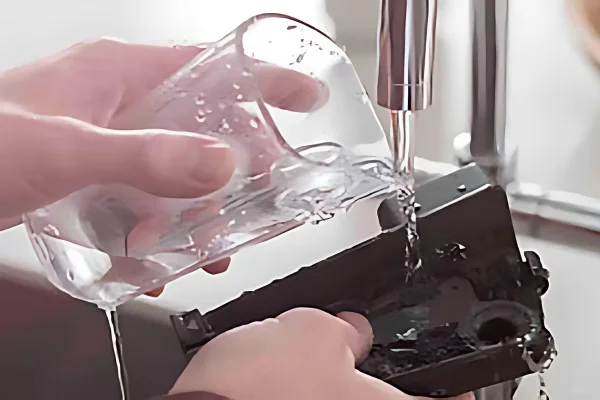
The Philips 3200 LatteGo’s milk system can only steam milk to one texture. This is a very thick milk froth. LatteGo milk frother detaches into three parts – dispenser, storage lid, and inner carafe.
I compared it to the Delonghi Dinamica Plus’s milk froth, and it was indistinguishable from the Dinamica Plus on its thickest milk setting (the Dinamica Plus gives you three milk texture settings).
The Philips 3200 LatteGo’s lack of texture variety means that all your milk drinks are quite similar.
I love that the Philips 3200 LatteGo’s milk container doesn’t use any rubber tubing.
Rubber tubing in a milk container inevitably leads to milk dripping all over your counter and to the tube crusting up with sour milk residue. The tube is really hard to clean because the holes in it are so small.
The LatteGo’s lack of rubber tubing makes it the easiest of any milk system to clean. All you have to do to keep it clean is to detach it into its three parts and put these parts into the dishwasher.
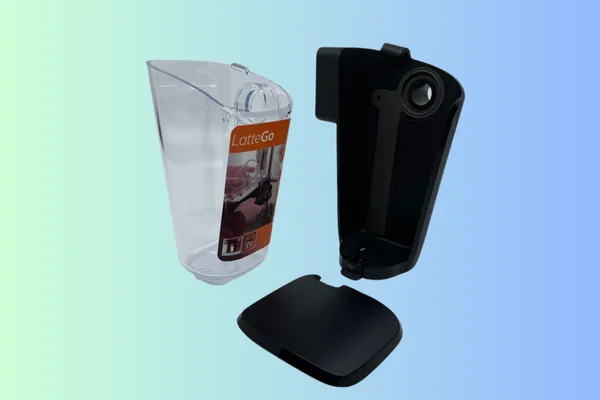
I have two very small complaints about the LatteGo’s milk system usability
- The LatteGo storage lid sits on the carafe rather than attaching to it: I’d often knock the lid off the carafe when removing it from the machine because of this.
- It’s hard to line up your cup so both its coffee and milk spout pour into it: I’ll often pour milk down the front of the outside of my cup and onto my drip tray because of this.
I also just want to warn you to make sure that you clip the inner part of the carafe into your outer part properly before you fill it up with milk.
Otherwise, it will leak milk.
Ceramic Flat Burr Grinder
The Philips 3200 has a ceramic flat burr grinder. While the grinder itself is perfectly fine, I am a bit concerned about how steam seems to rise up through the grind chute when it brews.
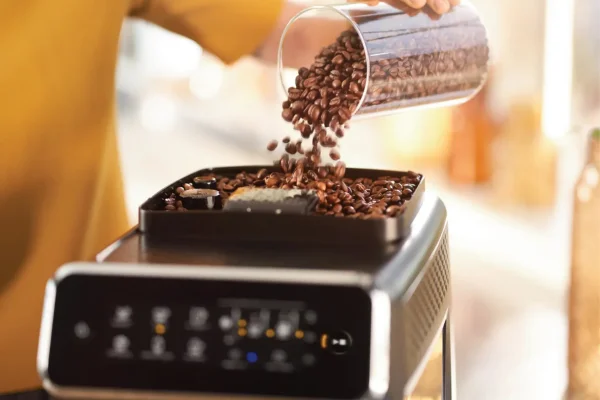
Philips likes to brag that their machines have a ceramic (rather than stainless steel) grinder and that this improves their machines’ espresso quality.
There’s very little evidence that this is particularly bad with the machines in this case. Both materials can grind your coffee beans to the same size and consistency.
I’d instead argue that Philips’ inferior brewing unit compared to its competitors (Delonghi and Jura) makes a far bigger difference to its espresso quality than its grinder material.
Anyway, the Philips 3200 LatteGo’s grinder has 12 grind size settings. I find that its lower settings (1-3) produce the best-tasting coffee.
My big concern with the Philips 3200 LatteGo’s grinder is that steam rises up through its grinder and bypasses the doser chute when you brew.
You can see this from the amount of condensation that builds up on the grinder lid.
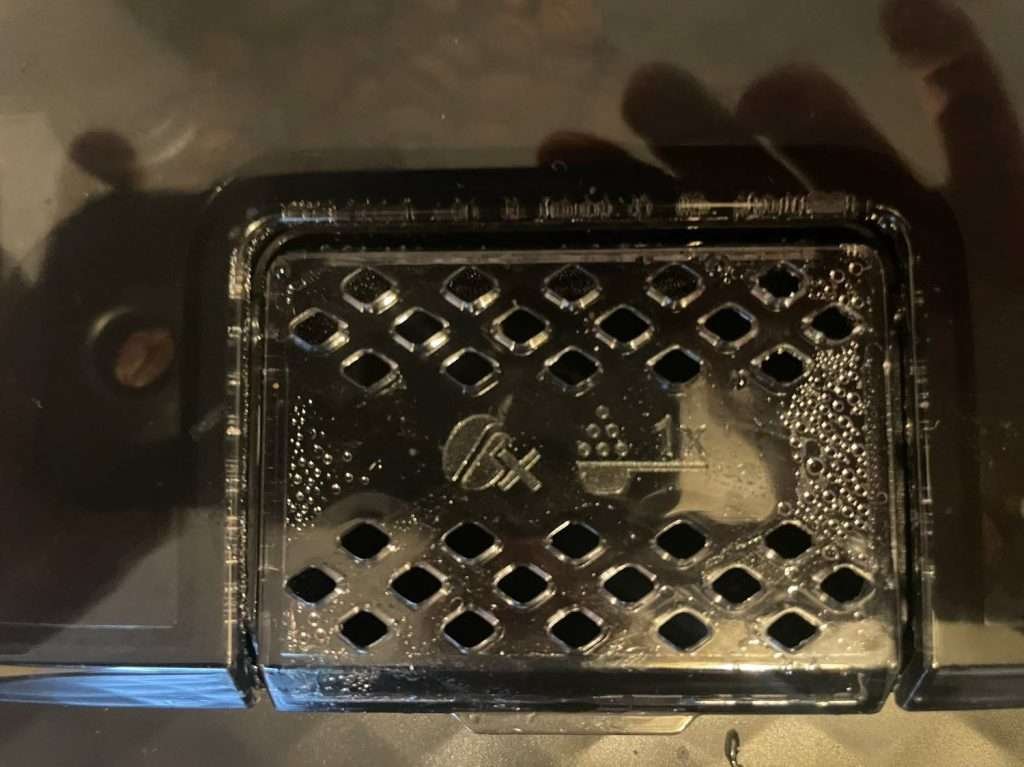
I can foresee this clogging up the grinder and bypassing the doser.
The bypass doser gets the worst of this condensation, so I outright wouldn’t recommend you use pre-ground coffee with this machine.
I’ve seen a few people complain about this happening to their Philips espresso machine on Reddit. You can see a thread of someone talking about this here.
You cannot remove a fully automatic espresso machine’s built-in grinder, so you’re pretty screwed if this happens to you.
Rinse Cycles and Cleaning the Machine
The machine rinses automatically when you turn it on. Make sure that you put a cup underneath your spout so you don’t flood your drip tray when this happens.
I like the fact that the machine does not rinse automatically after you make your coffee.
Delonghi machines do this, and this often leads to you having to hurriedly find a cup to put under your spout just as you want to enjoy your coffee in peace.
Other parts of the super-automatic espresso machine that require regular cleaning are:
- Its drip tray and used coffee grounds container should be emptied and cleaned (it’s dishwasher safe) every few days. Mold grows on espresso pucks very quickly.
- You need to run a rinse cycle using coffee tablets every month. Here’s a video showing you how to do this (watch from 1:22 to 3:13).
- You need to remove and rinse its brew group every few weeks.
- You need to replace its water filter every three months. The machine will remind you when you need to do this.
This cleaning is standard for a fully automatic espresso machine. Its lack of milk tubing and not running any unexpected rinse cycles means it’s less messy than most super automatics
Drip Tray – Plastic With Sharp Edges
The Philips 3200 LatteGo’s drip tray is made entirely out of plastic (don’t let the chrome finish on its grill fool you). It has a lot of sharp edges.
The Philips 3200’s drip tray isn’t nice to remove.
It has a lot of sharp edges. I can easily see myself cutting my hand on one of its edges, especially on the piece that covers the front of the drip tray.

Although the drip tray has an indicator float, it doesn’t visibly rise as the drip tray fills up so is basically useless.
I do like how much cup clearance the machine gives you. I can squeeze my travel mug in there.
Water Tank and Filter
The Philips 3200 LatteGo’s water tank is removed from the front. Its Aquaclean filter means that you can brew around 5000 coffees before it needs to be descaling.
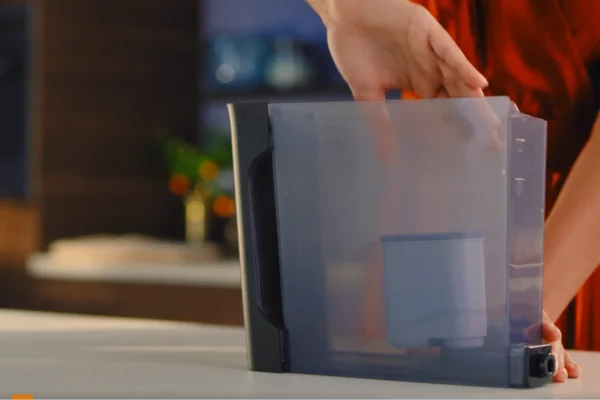
You do need to replace its Aquaclean water filter every three months, however.
I like how its water tank has a completely open lid. This makes it very easy to clean and quick to dry.
Removable Brew Group
You can remove the machine’s brewing unit to clean and lubricate it manually.
Being able to remove and lubricate the machine’s brew group should extend the machine’s lifespan.
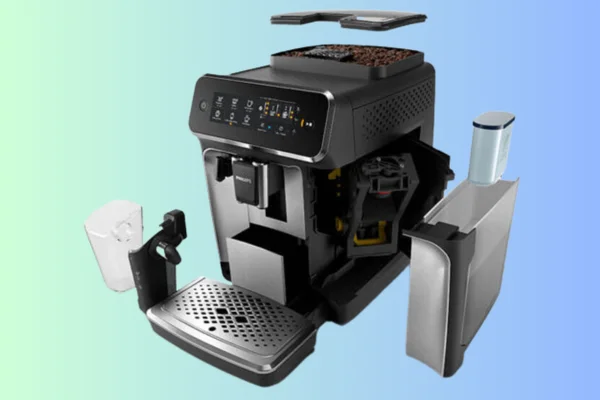
I don’t like how Jura super automatics don’t allow you to do this – it means you need to send the machine for servicing more often than necessary (a rouse to squeeze more money out of you in my opinion).
The Philips 3200 LatteGo even comes with a tube of lubricant to use on its brew unit.
Troubleshooting
The Philips 3200 has three error warning signs to indicate problems with the machine. I always think that telling you errors in Plain English is preferable to symbols, so this makes the machine more frustrating to troubleshoot than the Philips 4300 or 5400.
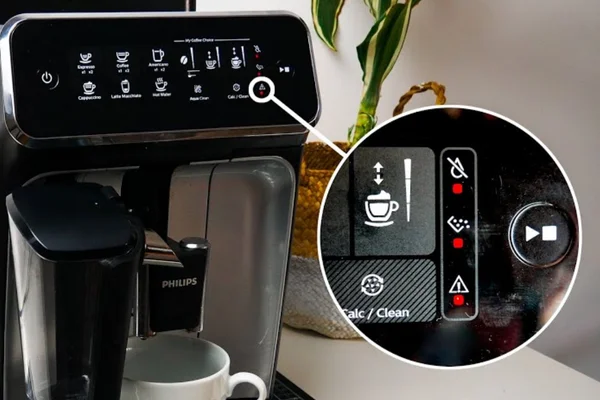
Here is what each error warning means:
- Top light is lit up: water tank is empty, missing or not in place properly
- Middle light is lid up: coffee grounds container needs emptying or is missing.
- Bottom light is lit up: The brew group is missing, clogged up or not in place properly.
- Bottom light + start/stop light is lit up: There is air trapped in the machine. Attach the nozzle attachment to the milk frother and press the start-stop button. This will eject all liquid and air from the machine.
- All warning lights are lit up at the same time: This is a general “your machine is screwed” warning. Try a hard reset. If it continues then it’s likely that the grinder is clogged up and your machine needs replacing. Sorry.
Again, it would be useful if the machine could tell you what the problem you needed to troubleshoot was in Plain English rather than through symbols.
This gives the Philips models with a digital display screen (4300 and 5400) a leg up over the 3200 when it comes to troubleshooting.
Now that I’ve gone through the Philips 3200 LatteGo’s basic features, I’m going to assess the machine along the following criteria.
Espresso quality
Milk steaming performance
User-friendliness
Ease of cleaning
Design and durability
Value for money
Espresso Quality
The Philips 3200 LatteGo produces a watery espresso lacking in depth in flavor.
This lack of flavor and body is because the holes in its brewing basket are too big.
You can see this by comparing the 3200’s brewing basket to one found on a Delonghi fully automatic espresso machine.
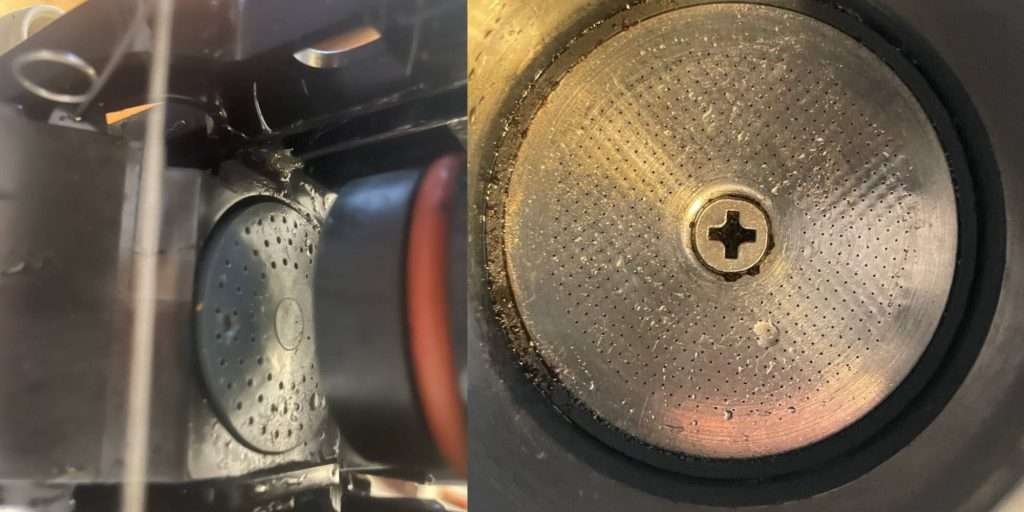
This means that water runs through your coffee puck too quickly (the holes are there to provide resistance to your water), so not enough of the flavorful compounds in your coffee extract into your water.
Espresso should be brewed in 25 – 30 seconds, but the Philips 3200 brews your espresso in around 15 seconds.
While the machine’s espresso is inferior to Jura and Delonghi super automatics, it’s still superior to Nespresso and around the same as what you’d get in a Moka pot.
The machine’s filter coffee is better than its espresso.
The machine grinds and brews three times for drip-style coffee. This automatically throttles the brewing process so the lack of resistance against your water is less of an issue.
Espresso Rating: ⭐⭐⭐ 5/10
Milk Steaming Performance
The Philips 3200 steams milk to a nice thick texture. It can only steam milk to one texture so while its milk drinks are nice, they’re all a bit similar.
The machine’s thick foam is good for drinks where coffee is topped with milk like cappuccino.
It will not give you the silky microfoam that you want for lattes (or latte art). I think that this is why Philips doesn’t include a latte on its menu.
Still, the 3200 LatteGo produces uniform milk foam by milk frother standards. You’ll never get as uniform a milk texture with a milk frother as you would with a steam wand (assuming you have a good milk steaming technique).
Milk Steaming Rating: ⭐⭐⭐⭐ 7/10
User Friendliness
The Philips 3200 LatteGo is easier to use than the majority of super-automatic espresso machines at its price point.
This user-friendliness is because all its drink option buttons are labeled with names rather than just with images.
With some Delonghi machines (like the ECAM series) buttons just have images on them and it’s not obvious which image corresponds to which coffee.
I also like how you can quickly change your coffee’s strength and size with one button press. This is another thing that most similarly priced fully automatic espresso machines don’t allow you to do.
The only way that the Philips 3200 LatteGo could be easier to use is if it had a display screen to walk you through maintaining and troubleshooting specific issues. This is something that you do get with the model’s upgrades, the Philips 4300 and 5400 LatteGo.
Ease of Use Rating: ⭐⭐⭐⭐ 8/10
Ease of Cleaning
The Philips 3200 is one of the easiest espresso machines to keep clean due to its lack of rubber milk tubes and it not going into random rinse cycles.
The two biggest causes of mess with a fully automatic espresso machine are:
- Rubber milk tubes: These drip milk on your counter and get crusty after just a few uses.
- Seemingly random rinse cycles: These can flood your drip tray if you don’t have a cup ready to catch it.
Fortunately, the Philips 3200 LatteGo doesn’t have any rubber milk tubes and it only rinses once when you turn it on.
This makes it one of the easiest super-automatic espresso machines to keep clean.
Its milk frother comes apart into three pieces, all of which can go in its dishwasher. Its used coffee grounds container can also go in the dishwasher.
The only parts you need to clean by hand are its drip tray and brewing unit (neither of these require daily cleaning).
Ease of Cleaning Rating: ⭐⭐⭐⭐⭐ 10/10
Design and Durability
The Philips 4300 has a cheap external build and does not feel like it will last long beyond its two-year warranty.
All of the machine’s external components are made out of plastic, this is particularly apparent when you remove its drip tray, which is incredibly flimsy and has a lot of sharp edges.
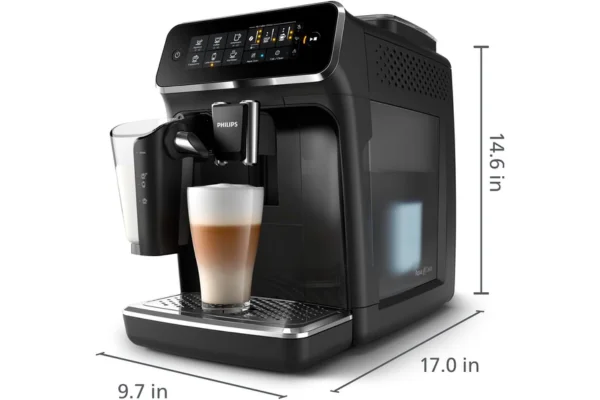
By far its biggest design flaw is the fact that steam rises up through its grinder chute when brewing. This is bound to cause blockages, and since you cannot remove its grinder, it can make the whole machine unusable when it happens.
People online also complain that the machine’s buttons lose responsiveness over time. This again is not surprising. Philips has clearly cut corners with the machine’s external build in order to keep their machines cheaper than Delonghi ones.
Design and Durability Rating: ⭐⭐ 4/10
Value for Money
The Philips 3200 LatteGo offers good value for money if you value usability and will mainly be making milk drinks.
The machine is just so much easier to use and keep clean than similarly priced models.
Value for Money Rating: ⭐⭐⭐⭐ 8/10
Philips 3200 LatteGo vs Other Philips Models
Philips has four LatteGo models: 2200, 3200, 4300, and 5400.
They differ in the following ways:
- Their number of menu items
- Their strength and size customizations.
- Their control panel
- Their number of user profiles
- Their price
Here is a table of how these models compare, they are listed from most affordable to most expensive.
| Machine Name | Black Drink Options | Milk Drink Options | User interface | User Profiles |
|---|---|---|---|---|
| Philips 2200 LatteGo | 2 | 1 | Buttons only | None |
| Philips 3200 LatteGo | 3 | 2 | Buttons only | None |
| Philips 4300 LatteGo | 5 | 3 | Button operated TFT screen | 2 |
| Philips 5400 Lattego | 7 | 5 | Button operated TFT screen | 4 |
The two best-value models are the Philips 3200 LatteGo and Philips 4300 LatteGo as they have the latte macchiato option (the machine’s best drink).
Your choice should depend on whether you’re willing to pay a bit more for a digital display screen user interface.
For more information on Philips fully automatic espresso machines please see my Philips 4300 LatteGo review and Philips 5400 LatteGo review.
Philips 4300 LatteGo vs Delonghi Magnifica Evo
Delonghi Magnifica Evo is better for plain espresso drinkers, and Philips 3200 LatteGo is better for milk drinkers.
The Philips 3200 LatteGo and Delonghi Magnifica Evo are two machines with very similar functionalities that cost pretty much the same.
I’d recommend the Delonghi Magnifica Evo over the Philips 3200 LatteGo if you’ll primarily be drinking plain espresso.
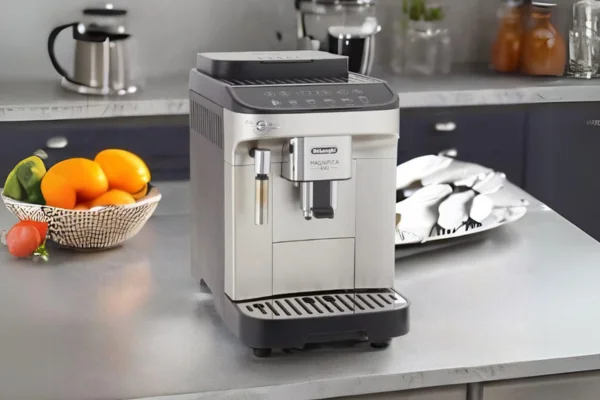
Delonghi Magnifica Evo
The Delonghi Magnifica Evo makes a better-tasting espresso than the Philips 3200 LatteGo. The two machines are similar in price.
I’d recommend the Philips 3200 if you’ll primarily drink milk drinks as its milk system is far easier to keep clean because it doesn’t rely on rubber tubing.
Their steamed milk quality is pretty much the same.
Philips 3200 LatteGo Review: Final Verdict
I’d recommend the Philips 3200 LatteGo if you’ll primarily drink milk drinks and your budget is capped at $800.

Philips 3200 LatteGo
The Philips 3200 LatteGo’s one-touch drink customizations and lack of milk tubing make it easier to use and keep clean than all other super-automatic espresso machines.
If you’d like to see what the other two big fully automatic espresso machine manufacturers have to offer then please see my roundup of the best Delonghi espresso machines and best Jura coffee machines.
